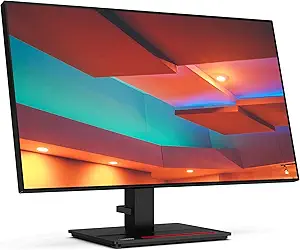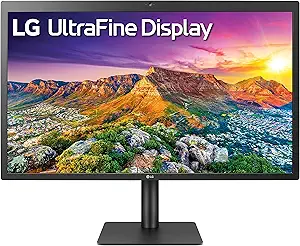In the ever-evolving landscape of technology, the choice of a monitor can significantly impact your computing experience, whether you're a professional, gamer, or casual user. Lenovo and LG, two distinguished names in the industry, offer a range of monitors tailored to meet diverse needs and preferences. As you navigate the maze of options, let's delve into the unique strengths and characteristics of Lenovo and LG monitors to help you make an informed decision.
Key Features Comparison
Size
When it comes to the size aspect of monitors, both Lenovo and LG offer a wide range of options to cater to different user needs. Lenovo monitors typically range from 19 inches to 27 inches, with their latest releases like the Lenovo Q27q-10 featuring a 27-inch QHD display. On the other hand, LG provides an even wider range with sizes going up to 49 inches, as seen in their latest LG 49WL95C-W model, which features a massive 49-inch UltraWide 32:9 Curved Display. In terms of advantages, Lenovo monitors' size range is sufficient for most standard computing tasks, including office work and casual gaming. They are also often more affordable and compact, making them suitable for users with limited desk space. However, they may not provide the immersive experience desired by hardcore gamers or multimedia professionals. On the other hand, LG's larger monitors offer a more immersive viewing experience, making them ideal for gaming, graphic design, and watching movies. Their larger size also allows for better multitasking with multiple windows open at the same time. However, these larger monitors are typically more expensive and require more desk space. Compared to other brands, both Lenovo and LG offer competitive size options, but LG stands out for its exceptionally large monitors.
Affordability
Lenovo and LG are both renowned brands in the monitor market, each offering a variety of models across different price ranges. Lenovo monitors are generally priced competitively, making them a popular choice among budget-conscious consumers. They offer a wide range of monitors with the latest technologies such as In-Plane Switching (IPS) panels, 4K resolution, and high refresh rates, all at a relatively affordable price. For instance, their ThinkVision series provides professional-grade performance at a reasonable cost, making them a great value for money. On the other hand, LG monitors are often priced slightly higher than Lenovo's, but they also tend to offer more advanced features and superior performance. LG's UltraGear and UltraWide series, for example, are equipped with cutting-edge technologies such as Nano IPS display, 1ms response time, and NVIDIA G-Sync compatibility, which are highly sought after by gamers and creative professionals. However, these high-end features come at a premium price, making LG monitors more expensive than most of their Lenovo counterparts. Nonetheless, consumers often find the higher price justified by the exceptional performance and quality that LG monitors deliver.
Reputation
Lenovo monitors have a solid reputation in the market for their reliability, quality, and innovative features. They are known for their cutting-edge technology such as the ThinkVision X1 with a 4K2K Ultra-HD resolution, which is one of the thinnest monitors in the world. Lenovo's monitors also come with a TÜV Eye Comfort certification, ensuring minimal eye strain during prolonged usage. However, the brand is often criticized for its customer service and slightly higher prices compared to other brands offering similar specifications. On the other hand, LG monitors are highly regarded for their exceptional display quality and advanced features. They are pioneers in incorporating the latest technologies like Nano IPS technology, which provides stunning visuals with accurate color at any viewing angle. LG's UltraGear™ Gaming Monitors are highly praised for their 1ms response time and a refresh rate of 144Hz, making them a preferred choice for gamers. However, some users have reported issues with the durability of LG monitors. Comparatively, LG monitors are usually priced competitively and they offer a wide range of options to cater to different user needs. Both brands have their strengths and weaknesses, and the choice between Lenovo and LG would largely depend on the specific requirements and budget of the user.
Picture Quality
Lenovo and LG are both renowned brands that offer a wide range of monitors, each with unique features and specifications. When it comes to picture quality, both brands have their strengths and weaknesses. Lenovo monitors, for instance, are known for their high resolution and vibrant color reproduction. The latest models, such as the Lenovo ThinkVision P27h, come with QHD (2560 x 1440) resolution, which delivers sharp and clear images. The In-Plane Switching (IPS) panel technology used in many Lenovo monitors ensures accurate and consistent colors from all viewing angles. However, some users have reported that Lenovo monitors may suffer from slight backlight bleeding, which can affect the picture quality in dark scenes. On the other hand, LG monitors are recognized for their exceptional color accuracy and contrast. The LG UltraFine 5K Display, for example, features a 5120 x 2880 resolution and P3 wide color gamut, offering stunning detail and rich colors. LG's monitors also employ IPS panel technology, but they often include additional features like HDR10 for improved contrast and color range. LG's Nano IPS technology, which applies nanometer-sized particles to the screen's LED to absorb excess light wavelengths, further enhances color accuracy. However, LG monitors are sometimes criticized for their lower peak brightness compared to other brands, which may affect the picture quality in brightly lit environments.
Connectivity
Lenovo and LG monitors are both renowned for their advanced features and high-quality displays, but they differ significantly when it comes to their connectivity options. Lenovo monitors, such as the ThinkVision P27h, offer a variety of connectivity options including HDMI 1.4, DisplayPort 1.2, and USB Type-C ports that support video and data transmission, and provide up to 90W power charging. This is a distinct advantage for users who need to connect multiple devices simultaneously or require high-speed data transfer. However, the absence of newer HDMI and DisplayPort standards can limit the display capabilities, especially for high-resolution gaming or professional graphics work. On the other hand, LG monitors, like the UltraFine 5K display, are equipped with the latest connectivity technologies. They feature Thunderbolt 3 ports that provide video, data and power over a single cable, and support for 5K video, audio, and data simultaneously. Additionally, they also have three downstream USB Type-C ports for additional connectivity. However, the lack of HDMI and DisplayPort can be a disadvantage for users with devices that do not support USB Type-C or Thunderbolt 3. In comparison to other brands, both Lenovo and LG offer competitive connectivity options, but LG stands out for its adoption of newer standards and technologies.
Production Selection
When it comes to the production selection of monitors, both Lenovo and LG offer a variety of options to cater to different user needs. Lenovo monitors are known for their high-quality display and performance. They come in a range of sizes, from smaller 21.5-inch models to larger 27-inch and 32-inch models, with options for both Full HD and 4K resolution. Some of their latest models, such as the Lenovo ThinkVision P27h, also feature USB-C connectivity, adjustable stands, and blue light reduction technology. However, Lenovo monitors tend to be more expensive compared to other brands, and some users have reported issues with customer service. On the other hand, LG monitors are renowned for their innovative features and design. They offer a wide selection of monitors, including gaming monitors with high refresh rates, professional-grade monitors with accurate color reproduction, and ultrawide monitors for multitasking. LG's latest models, such as the LG UltraFine Display OLED Pro, incorporate cutting-edge technologies like OLED display and HDR10 support. LG monitors are generally more affordable than Lenovo monitors, but some users have noted that they may not be as durable or long-lasting. In comparison to other brands, LG tends to focus more on the design and aesthetic aspect of their monitors, while Lenovo puts more emphasis on performance and functionality.
Conclusion
In terms of the latest technologies, both Lenovo and LG monitors offer a variety of high-end features. Lenovo monitors are equipped with In-Plane Switching (IPS) technology, providing wide viewing angles and vibrant colors. They also feature anti-glare screens and are often designed with adjustable stands for ergonomic comfort. On the other hand, LG monitors are well-known for their IPS panels as well, but they also offer monitors with Nano IPS technology, which enhances color accuracy. LG monitors also feature AMD FreeSync technology, which reduces screen tearing and stuttering for a smoother gaming experience. In comparison to other brands, Lenovo and LG monitors both have their unique strengths. Lenovo monitors are often praised for their robust build quality and professional design, making them ideal for office settings. However, they may lack in the gaming department, where refresh rates and response times are crucial. Conversely, LG monitors are often lauded for their excellent gaming performance and superior color accuracy, making them suitable for both gaming and professional content creation. However, some users have reported issues with the durability of LG monitors. In summary, the choice between Lenovo and LG monitors largely depends on the specific needs and preferences of the user.




















